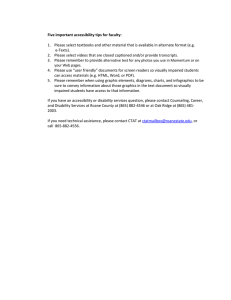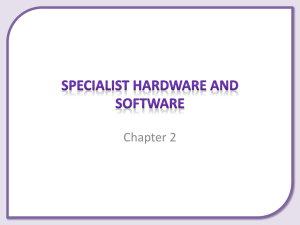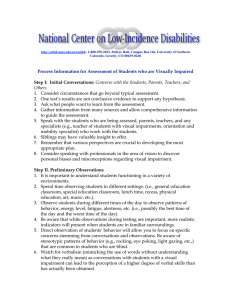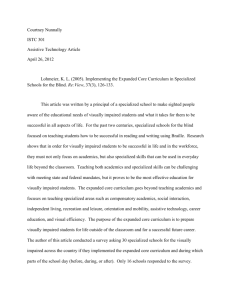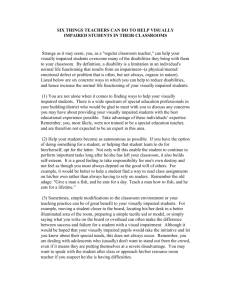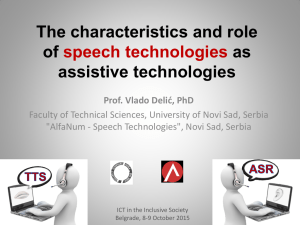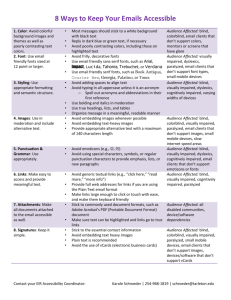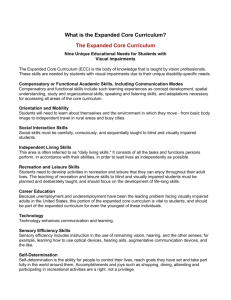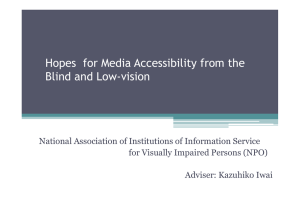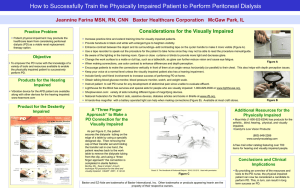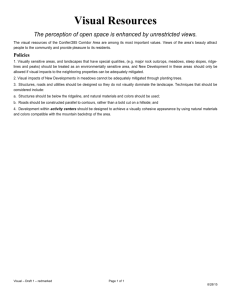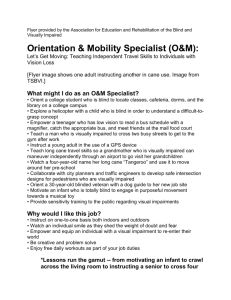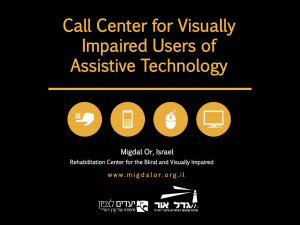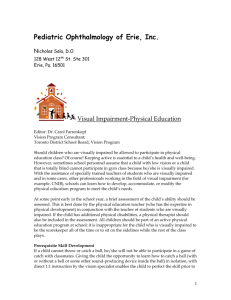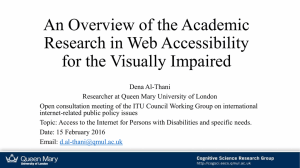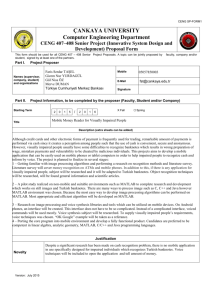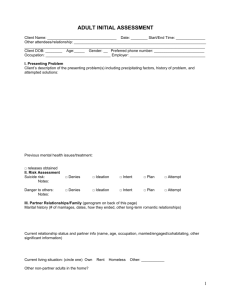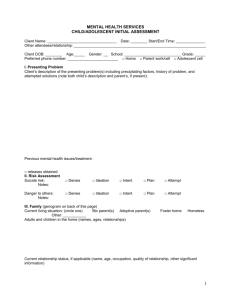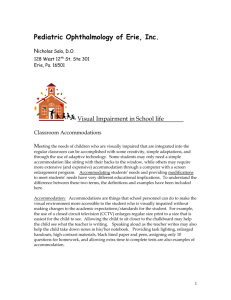Sunny Lin Improving Health Information Access for the Visually
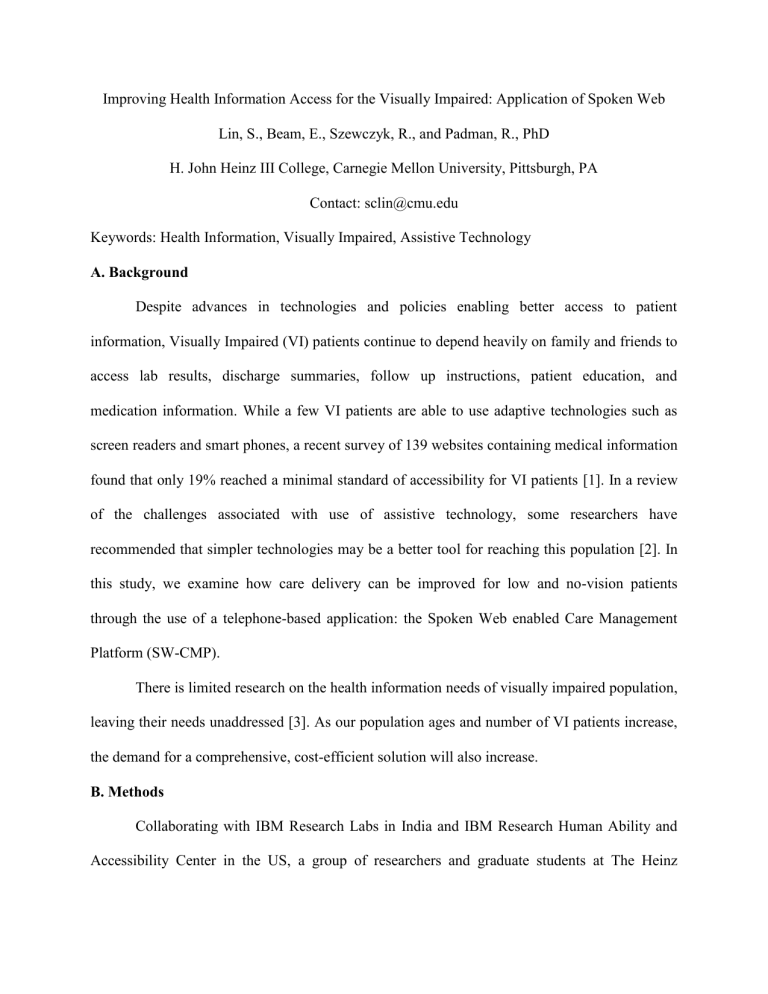
Improving Health Information Access for the Visually Impaired: Application of Spoken Web
Lin, S., Beam, E., Szewczyk, R., and Padman, R., PhD
H. John Heinz III College, Carnegie Mellon University, Pittsburgh, PA
Contact: sclin@cmu.edu
Keywords: Health Information, Visually Impaired, Assistive Technology
A. Background
Despite advances in technologies and policies enabling better access to patient information, Visually Impaired (VI) patients continue to depend heavily on family and friends to access lab results, discharge summaries, follow up instructions, patient education, and medication information. While a few VI patients are able to use adaptive technologies such as screen readers and smart phones, a recent survey of 139 websites containing medical information found that only 19% reached a minimal standard of accessibility for VI patients [1]. In a review of the challenges associated with use of assistive technology, some researchers have recommended that simpler technologies may be a better tool for reaching this population [2]. In this study, we examine how care delivery can be improved for low and no-vision patients through the use of a telephone-based application: the Spoken Web enabled Care Management
Platform (SW-CMP).
There is limited research on the health information needs of visually impaired population, leaving their needs unaddressed [3]. As our population ages and number of VI patients increase, the demand for a comprehensive, cost-efficient solution will also increase.
B. Methods
Collaborating with IBM Research Labs in India and IBM Research Human Ability and
Accessibility Center in the US, a group of researchers and graduate students at The Heinz
College at Carnegie Mellon University have conceptualized and implemented a telephone-based, prototype healthcare delivery application (SW-CMP) that functions as a multi-pronged clinical and self-help intervention to allow patients, providers and caregivers to: (1) Securely create, update, manage and monitor an individual's health records; (2) Improve basic health literacy via education modules and social collaboration tools; (3) Engage the patient in recommended selfcare behaviors via automated reminders for clinical monitoring and follow-up care and appointments; (4) Practice evidence-based medication management using automated reminders for med-adherence, alerts for dosage adjustments, and warnings about adverse drug events [4].
Several initial interviews and focus group activities with members of the PA Council of the Blind and staff from the Blind and Rehabilitation Services of Pittsburgh have provided preliminary information on the needs and priorities of VI patients, as well as their opinions on the strengths, weaknesses and uses of SW-CMP. In the future, we plan to survey patients at low vision clinics and support groups in the Pittsburgh area to assess information needs of VI patients, features of SW-CMP that are important to users, and explore existing solutions to this problem. Participants will be invited to test the prototype by completing a set of tasks and taking a pre and post survey on usability and key features.
C. Results
Early results indicate that interviewees favored features such as accessibility without dependence on other people or advanced technology, patient education components, secure messaging, the ability to store recent and historical lab results, and the ability to alert patients about abnormal lab results, medication changes, and upcoming appointments. They also suggested features such as allowing for the sharing of patient information with chosen providers, multiple access points (being able to access the information via phone, smart phone, and
internet), and a discussion board. Participants expressed concern over doctor’s willingness to use the tool and possible privacy dangers.
D. Discussion
Our pilot evaluations reveal that there is a strong need for an information solution for the
VI, but no products currently meet this need. Some participants have asked their doctors to email important information to them; however, only one doctor was willing to do so due to time and
HIPAA concerns. While the prototype was met with enthusiasm, surveyed participants cited its lack of skip and speed controls as a major barrier to use, as well as inconsistent navigation instructions and unclosed loops, which can be addressed using navigation controls and voice synthesizers. Currently, we are investigating extensions of the SW-CMP using new technologies that provide linkages to the Internet and enable multi-media integration so that the technology is useful to a broader population that includes the underserved and elderly.
For VI patients with chronic diseases or acute conditions, a large gap in the delivery of healthcare information is a liability in patient care [5]. Existing, pervasive technologies, accessible to all patients who can use a telephone, can fill this gap. As federal policies nudge healthcare towards a more patient-centered approach, providers and patients will increasingly look towards these kinds of solutions to make quality patient care easy, affordable and accessible.
References
1.
Lüchtenberg, M., Kuhli-hattenbach, C., Sinangin, Y., Ohrloff, C., & Schalnus, R. Accessibility of health information on the internet to the visually impaired user. Ophthalmologica . 2008; 222(3): 187-93.
2.
Bobbi L. Hillen, LCSW; Felix M. Barker II, OD, MS; Mary G. Lawrence, MD, MPH; COL Donald A.
Gagliano, MD, Harnessing the Power of Information Technologies for the Visually Impaired. Federal
Practitioner . November 2012.
3.
Bath, P. A., Beverley, C. A., & Booth, A. Health information needs of visually impaired people: A systematic review of the literature. Health and Social Care in the Community . 2004: 12(1), 1-24.
4.
R. Padman, E. Beam, R. Szewczyk, A. Kumar, S. Agarwal, M. Puri, M. Singh, A. Nanavati, P. Khera,
"Engineering and pilot proxy evaluation of a spoken web enabled care management platform", Proceedings of
UKAIS Conference , Worcester College, Oxford University, UK. 2013.
5.
Mc
Cann RM, Jackson AJ, Stevenson M, Dempster M, McElnay JC, Cupples ME. “Help needed in medication self-management for people with visual impairment: case-control study.” British Journal of General Practice.
August 2012: 62(601), 530-7.
